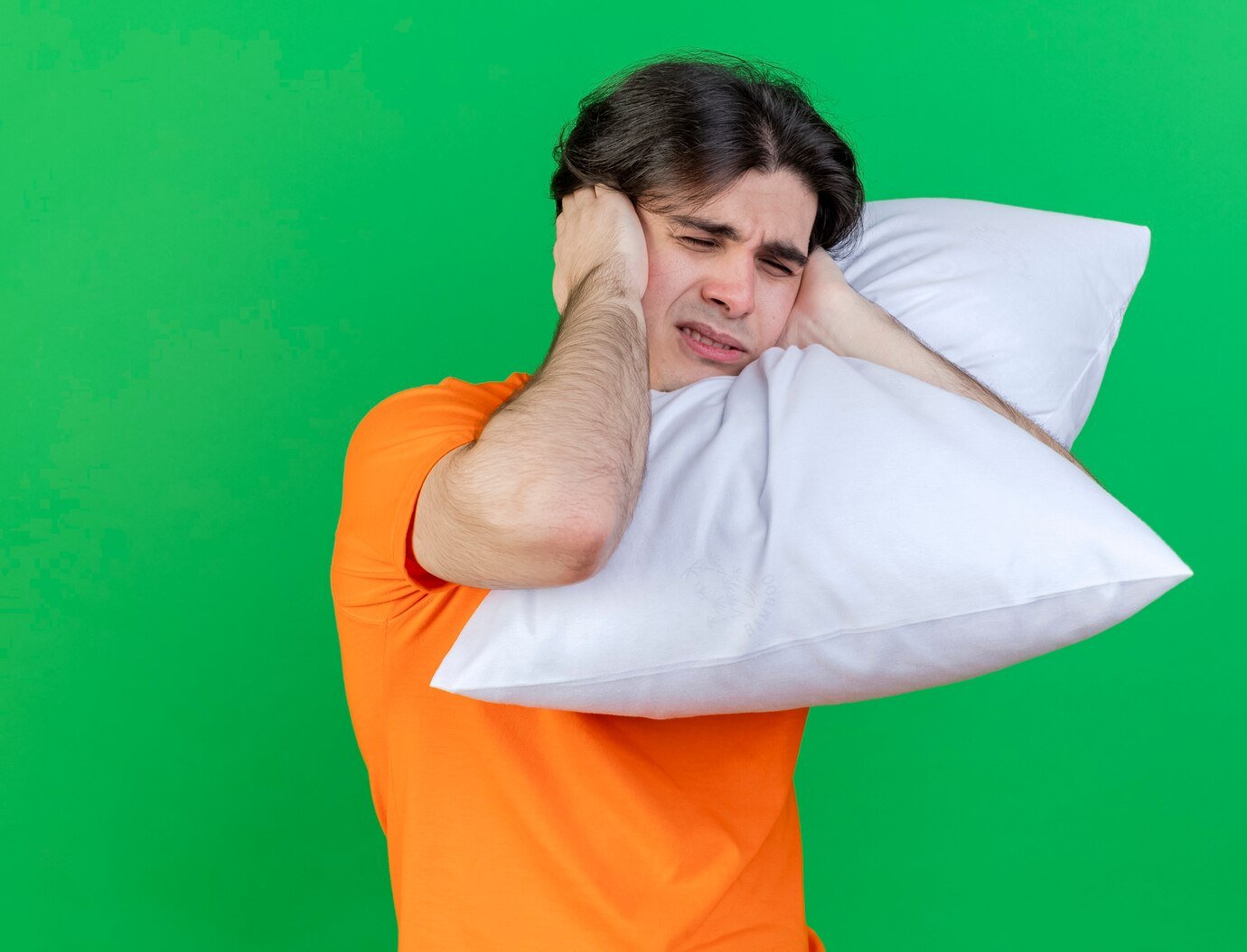Health & Fitness
What Side Should I Sleep on With a Ruptured Eardrum? Expert Tips for Comfort & Healing

A ruptured eardrum can be painful, uncomfortable, and disruptive to daily life. Sleep, which is essential for healing, can be particularly challenging when dealing with this condition. If you’re wondering what side should I sleep on with a ruptured eardrum, the answer depends on multiple factors, including pain levels, drainage, and ear protection. Choosing the correct sleep position can reduce discomfort, minimize complications, and support the body’s natural healing process.
Understanding a Ruptured Eardrum
A ruptured eardrum, also called a tympanic membrane perforation, occurs when the thin membrane separating the ear canal from the middle ear gets torn. This condition can result from infections, sudden pressure changes, trauma, or exposure to loud noises.
Symptoms of a Ruptured Eardrum
- Sudden ear pain
- Partial or complete hearing loss
- Ringing or buzzing sounds (tinnitus)
- Fluid or pus drainage
- Dizziness or balance issues
While most perforations heal on their own within a few weeks, proper care—especially during sleep—can prevent complications.
What Side Should I Sleep on With a Ruptured Eardrum?
The best sleep position depends on whether your ear is actively draining and how much discomfort you experience. Consider these factors when choosing your sleeping position:
Sleeping on the Unaffected Side
Sleeping on the unaffected side is often the best choice. This position prevents excess pressure on the injured ear, allows proper drainage, and reduces the risk of further irritation.
Sleeping on the Affected Side (With Caution)
In some cases, sleeping on the affected ear may be recommended if your ear needs to drain. Gravity helps fluids exit, reducing the risk of infection buildup. However, this should be done with medical guidance.
Sleeping With the Head Elevated
Raising your head slightly using an extra pillow can reduce pressure buildup in the middle ear, ease pain, and prevent fluid accumulation. This is especially helpful if lying flat increases discomfort.
Best Sleeping Positions for Comfort & Recovery
Side Sleeping With the Affected Ear Up
- Prevents unnecessary pressure on the eardrum
- Reduces pain and irritation
- Minimizes the risk of fluid buildup
Side Sleeping With the Affected Ear Down (If Recommended by a Doctor)
- Assists with drainage if fluid is present
- Helps prevent inner ear infections
- Requires a clean pillowcase or medical gauze for hygiene
Back Sleeping With Head Elevated
- Reduces pressure in the ear
- Promotes better circulation and healing
- Helps with sinus drainage that can impact the eardrum
Tips for Sleeping Better With a Ruptured Eardrum
Use a Supportive Pillow
A firm but comfortable pillow can help maintain proper head positioning throughout the night. Memory foam or cervical pillows work well for keeping the head elevated.
Avoid Sleeping on the Stomach
Stomach sleeping places undue pressure on the ears and can worsen discomfort. It also makes it harder to control head positioning.
Maintain Ear Hygiene Before Bed
If there’s fluid drainage, gently clean the outer ear with a soft, clean cloth before lying down. Avoid inserting anything inside the ear canal.
Use Ear Drops or Medications as Directed
If your doctor prescribes ear drops or antibiotics, use them before bedtime to reduce inflammation and discomfort while sleeping.
Control Room Environment
Keeping the bedroom quiet, dark, and comfortable can improve sleep quality. White noise machines or soft music can also mask tinnitus-related disturbances.
Finding the right sleeping position when dealing with a ruptured eardrum is crucial for healing and comfort. Sleeping on the unaffected side or with the head elevated is generally the best choice. However, individual circumstances may require adjustments, so consulting a healthcare professional is always advisable.
By prioritizing proper sleep habits and ear care, you can recover smoothly and prevent complications.
Health & Fitness
From Paperwork to Peace of Mind: The Real Benefits of NDIS Plan Management in Sydney

Let’s be honest. The NDIS can feel like a maze. A really important maze, but still—paperwork, invoices, budgets, acronyms stacked on acronyms. For many participants in Sydney, the relief doesn’t come from magically understanding it all overnight. It comes from support. And one type of support in particular keeps coming up again and again—NDIS Plan management in Sydney.
Now, plan management isn’t the flashy part of the NDIS. It doesn’t get the spotlight like therapies or new assistive tech. But it’s quietly powerful. It’s what helps turn a plan on paper into something that actually works in daily life. And for a city like Sydney—diverse, busy, sometimes overwhelming—it can be the thing that makes the whole system feel a little more human.
What Is Plan Management, Really?
A lot of people mix it up with support coordination—different thing. Plan management is about the money side of your NDIS plan—tracking budgets, paying invoices, and keeping things compliant. The boring-but-essential stuff that most of us would rather not spend hours on.
With NDIS Plan management in Sydney, you basically get someone (a registered plan manager) who becomes your personal finance assistant for the NDIS. They make sure providers get paid, budgets are balanced, and you don’t accidentally overspend or underspend. And the best part? It doesn’t cost you anything out of pocket—plan management is funded within the NDIS itself if you choose it.
So, instead of stressing over invoices piling up in your inbox, you can get back to… well, life.
Why Sydney Makes It Interesting
Sydney isn’t just another city. It’s huge, busy, multicultural, and full of providers. That’s a blessing and a headache at the same time. On one hand, you’ve got choices everywhere—therapy clinics in Parramatta, support workers in the Inner West, equipment suppliers out in Penrith. On the other hand, all those options can feel like white noise. Too many tabs open in your brain.
That’s where NDIS Plan management in Sydney stands out. A good plan manager won’t just shuffle invoices around. They’ll help you make sense of all those choices, keeping you in control while clearing the clutter. Think of them as the person holding the clipboard while you’re trying to run the marathon. They’re not running it for you, but they make sure you don’t trip over your shoelaces.
The Peace-Of-Mind Factor
Here’s something you don’t see on official fact sheets: the emotional side of plan management. For many families, it’s not about whether they can manage the money. It’s about whether they want the stress of doing it on top of everything else.
Imagine a parent in Bankstown juggling work, caring for their child, and managing multiple therapy providers. Or an older participant in Chatswood who finds online portals intimidating. In both cases, NDIS Plan management in Sydney isn’t just financial—it’s peace of mind. It’s that exhale moment where you hand over the stressful bits and trust someone else to carry them.
Flexibility Without Chaos
One of the underrated perks of having a plan manager is freedom. If you go fully agency-managed, you can only use registered NDIS providers. That cuts out a big chunk of the market. But with NDIS Plan management in Sydney, you get the flexibility to choose both registered and unregistered providers.
That could mean booking a small, local physio who isn’t on the official register but is brilliant at what they do. Or maybe it’s working with a culturally specific provider who understands your background. In Sydney, with its layers of communities and cultures, that flexibility is tremendous. It’s choice without chaos.
But… Is It Really Necessary?
Some people wonder if they should just self-manage. And sure, for the ultra-organised, detail-loving folks out there, that can work. But for most people, the extra layer of admin just drains energy. NDIS Plan management in Sydney offers a middle ground—flexibility like self-management, but without the endless spreadsheets and compliance checks.
It’s not about ability. It’s about sustainability. Just because you could spend your Saturday evening chasing invoices doesn’t mean you should.
Stories That Stick
I once heard from a participant who described their plan manager as “the person who makes my life make sense.” That might sound dramatic, but think about it. They had five different providers across the city, all billing separately. Before plan management, payments were late, appointments got tangled, and stress levels spiked. After? Smooth sailing. The participant could focus on progress instead of paperwork.
That’s the ripple effect of NDIS Plan management in Sydney. It’s invisible when it works, but deeply felt.
Looking Ahead
With technology improving, plan managers are starting to use apps, dashboards, and even SMS updates to keep participants in the loop. Sydney, being the fast-paced city it is, is already seeing these tools roll out. Imagine checking your NDIS budget on your phone while sitting on the train. No stress, no guessing. Just clarity.
The future of NDIS Plan management in Sydney isn’t just about keeping up with the system—it’s about making it participant-friendly, transparent, and maybe even simple.
Final Thought
If there’s one thing to take away, it’s this: you don’t have to carry the weight of the NDIS alone. Choosing NDIS Plan management in Sydney from Sky Plan Management is less about giving up control and more about sharing the load. It’s about focusing on goals, health, and independence—while someone else keeps the financial gears turning in the background.
Because at the end of the day, the NDIS is supposed to help people live better lives, not drown in paperwork. Plan management is how that vision gets closer to reality. Especially here, in Sydney, where life is fast, loud, and full of possibilities.
Health & Fitness
Wellness Twist | Herbal Shisha for Health-Conscious Nights

When the craving hits but the guilt creeps in, what then? Late nights in Dubai often come with a ritual: dim lights, soft music, and that familiar swirl of smoke. But for many, the old-school shisha habit feels like a contradiction, comfort laced with concern. That’s where Herbal Shisha steps in, not as a compromise, but as a wellness twist on tradition.
Forget the tobacco. This is about mindful smoking, a plant-based shisha experience that’s nicotine-free, smoother on the lungs, and surprisingly satisfying. The herbal molasses blend? It’s not just a technical swap. It’s a shift in mindset. You’re not chasing a buzz, you’re curating a vibe. I used to think shisha meant choosing between pleasure and health. Turns out, you can have both. Herbal Shisha isn’t just smoke-free, it’s stress-free. For health-conscious nights that still feel indulgent, this is your new go-to.
The Shift Toward Tobacco-Free Hookah Culture
It’s not just smoke, it’s a statement. In Dubai’s ever-evolving lounge scene, the shift toward tobacco-free hookah isn’t some passing wellness fad. It’s a cultural pivot. One that’s reshaping how people unwind, socialize, and even define luxury. Walk into any upscale lounge in Jumeirah or DIFC, and you’ll notice it: menus now feature Herbal Shisha, not buried at the bottom, but proudly listed as a premium option.
Why? Because the demand is real. Health-conscious guests are asking for nicotine-free smoking experiences that still feel indulgent. And herbal molasses, made from sugarcane, tea leaves, or dried fruit, delivers that smooth pull without the harsh aftermath. No buzz, no burnout. Just flavor, aroma, and calm.
Regulations are nudging things forward, too. With tighter controls on tobacco use in public spaces, Herbal Shisha offers lounges a compliant, wellness-aligned alternative. It’s not about quitting, it’s about choosing better. Even wellness retreats and rooftop yoga events are embracing Herbal Shisha as part of the experience. Sounds odd? Maybe. But when the smoke clears, it makes perfect sense.
What Is Herbal Shisha?
Herbal Shisha Dubai is not just a tobacco substitute; it’s a complete reimagining of the hookah experience. Instead of tobacco leaves soaked in nicotine-heavy syrup, Herbal Shisha uses plant-based ingredients like dried fruits, tea leaves, or sugarcane pulp. These are blended with herbal molasses and glycerin, creating a smooth, flavorful smoke without the addictive kick.
Preparation is nearly identical to traditional shisha. You pack the bowl, heat the charcoal, and inhale through the hose. But what you’re breathing in is nicotine-free hookah vapor, no tobacco, no tar, no lingering harshness. Just aroma and relaxation.
It’s not perfect. Some say the buzz is missing. But for those chasing a wellness-aligned ritual, Herbal Shisha offers a cleaner, calmer alternative. And yes, it still clouds the room like a dream.
Ingredient Breakdown | What Goes Into Herbal Shisha?
Let’s be honest, most people don’t ask what’s inside their shisha. They just light up and hope for the best. But if you’re leaning toward a smoke-safe shisha lifestyle, knowing the ingredients matters.
Herbal Shisha skips the tobacco entirely. Instead, it’s built on a glycerin hookah base, which helps produce thick, satisfying clouds without the toxins. The core? A blend of herbal ingredients, usually dried fruit pulp, tea leaves, or sugarcane fiber. These are soaked in herbal molasses, a sticky, sweet binder that mimics the texture of traditional shisha. Here’s what typically goes into a quality Herbal Shisha mix:
- Vegetable glycerin (for vapor production)
- Herbal molasses (natural binder)
- Dried fruit pulp or sugarcane fiber (base material)
- Tea leaves or other plant matter (for texture and aroma)
- Natural flavoring agents like mint, rose, blueberry, or chai
- Preservative-free sweeteners (optional, depending on brand)
Then comes the fun part: natural flavoring. From mint and rose to blueberry and chai, these extracts give Herbal Shisha its signature aroma and taste. No synthetic chemicals. No nicotine. Just a tobacco-free blend that feels indulgent but sits lighter on your lungs. It’s not just what you smoke, it’s what you skip. And that’s the real upgrade.
Benefits of Herbal Shisha
Let’s strip it down. You want the vibe, not the baggage. That’s where Herbal Shisha earns its place, not as a watered-down version of the real thing, but as a smarter, smoother alternative for people who care what they’re breathing in. Here’s why it’s catching on in Dubai’s lounges and homes:
- Nicotine-free | No addictive compounds, no withdrawal drama. Just clean, flavorful vapor.
- Tobacco-free blend | No tar, no tobacco leaf, no harsh throat hit. Your lungs will thank you.
- Wellness-aligned | Fits into smoke-free lifestyles, especially for those cutting back or detoxing.
- Aroma-rich experience | Thanks to natural flavoring agents, it still delivers that sensory indulgence.
- Less residue, less odor | You won’t walk out smelling like a bonfire. Your clothes and cushions stay fresh.
- Customizable | Mix herbal molasses with different bases, tea leaves, dried fruit, and sugarcane for a tailored taste and texture.
I’ve seen people switch not because they had to, but because they wanted to. One friend swapped his late-night tobacco sessions for Herbal Shisha during Ramadan. Said it helped him stay grounded without feeling deprived. That’s the kind of shift we’re talking about, not just health, but habit.
Herbal Shisha vs. Traditional Shisha | A Comparative Breakdown
Let’s not sugarcoat it: Herbal Shisha and traditional shisha might look the same in a lounge setup, but they’re worlds apart once you light the coal. This isn’t just a tobacco-free comparison; it’s a shift in how people define pleasure, wellness, and social rituals. Here’s a breakdown that cuts through the haze:
| Feature | Herbal Shisha | Traditional Shisha |
|---|---|---|
| Base Ingredient | Herbal molasses, dried fruit, and tea leaves | Tobacco leaves soaked in flavored molasses |
| Nicotine Content | Nicotine-free hookah | High nicotine levels |
| Health Impact | Lower risk, no tar or tobacco toxins | Linked to respiratory and cardiovascular issues |
| Flavor Profile | Milder, aroma-rich, customizable | Stronger, often harsher |
| Legal Flexibility | Lounge-friendly, wellness-compliant | Restricted in some public venues |
| Aftertaste & Odor | Light fades quickly | Lingering smoke smell |
| Audience Appeal | Health-conscious, wellness-focused | Traditional smokers, buzz-seekers |
Herbal Shisha isn’t trying to be a clone; it’s a hookah alternative built for people who want the ritual without the risk.
Nighttime Rituals | How Herbal Shisha Enhances the Experience
Evenings in Dubai carry a rhythm, slow, intentional, and often shared. Whether it’s rooftop conversations, solo wind-downs, or quiet reflection after a long day, Herbal Shisha fits right in. It’s not just about smoke, it’s about setting a tone for health-conscious nights that still feel indulgent.
Unlike traditional hookah, Herbal Shisha invites a kind of mindful smoking. No nicotine rush, no heavy buzz, just a warm pull of flavor that complements your mood. I’ve seen people pair it with journaling, soft jazz, or even guided meditation. Sounds odd? Maybe. But it works.
For social settings, it’s a game-changer. You can pass the hose, share stories, and stay present, without the foggy aftermath. It’s become part of the wellness ritual for many, especially those who crave the ambiance of evening hookah without compromising their lifestyle. It’s not a trend. It’s a quiet revolution in how we unwind.
Lounge Trends | Herbal Shisha Adoption in Urban Spaces
Walk into a lounge in Dubai’s Al Quoz or City Walk, and you’ll notice something subtle but telling: Herbal Shisha is no longer the “alternative.” It’s the main event. As wellness culture seeps into nightlife, herbal hookah lounges are reshaping the vibe with tobacco-free menus that feel just as indulgent, minus the health baggage.
Owners are responding to demand. Guests want nicotine-free shisha that pairs well with mocktails, ambient playlists, and rooftop views. It’s not just about smoking, it’s about curating an experience that aligns with urban wellness values.
From boutique cafés to high-end lounges, Herbal Shisha is becoming the go-to for conscious consumers. The shift isn’t loud; it’s quiet, intentional, and everywhere. And for many, it’s the first time they’ve felt good about lighting up.
Flavor Profiles That Resonate with Wellness Seekers
If you think Herbal Shisha means bland, think again. The flavor game is strong and surprisingly refined. For wellness-focused users, it’s not just about taste. It’s about how each pull complements mood, breath, and intention. Here’s a lineup of natural hookah flavors that have earned their place in Dubai’s wellness lounges:
- Mint | Cooling, crisp, and perfect for post-work wind-downs
- Rose | Floral, subtle, and ideal for slow, meditative sessions
- Green Tea | Earthy, calming, and pairs well with herbal molasses
- Lemon Verbena | Bright, citrusy, and great for mental clarity
- Lavender | Soft, aromatic, and surprisingly grounding
- Blueberry | Sweet, fruity, and a favorite in plant-based blends
- Chai Spice | Warm, spiced, and perfect for cooler desert nights
Herbal Shisha isn’t just flavor-rich, it’s emotionally tuned. Each blend feels curated, not manufactured. And that’s what keeps wellness seekers coming back.
Legal & Licensing Benefits of Herbal Shisha
Here’s where Herbal Shisha quietly wins. Because it’s a tobacco-free product, it bypasses many of the strict hookah regulations that apply to traditional shisha. In Dubai and other wellness-forward cities, this means fewer hurdles for lounge owners, retailers, and event organizers.
Unlike tobacco-based blends, legal Herbal Shisha does not require the same level of licensing, import restrictions, or health warnings. Its nicotine-free approval status makes it easier to feature on menus, especially in venues that prioritize tobacco-free compliance.
For entrepreneurs, this opens doors. You can launch a herbal hookah lounge, host pop-up wellness nights, or sell direct-to-consumer without navigating the red tape that comes with tobacco. It’s not just safer, it’s smarter business.
Buying Guide | What to Look for in Herbal Shisha Products
Not all Herbal Shisha is created equal. Some blends promise wellness but deliver weak flavor and thin smoke. If you’re serious about switching to premium herbal shisha, here’s what to look for when ordering shisha home delivery in Dubai, without falling for flashy packaging.
- Ingredient transparency | Check the label. A good blend lists herbal molasses, glycerin, and real plant-based components, not vague “flavoring agents.”
- Smoke density | Quality Herbal Shisha should produce thick, satisfying clouds. If it fizzles out fast, it’s probably overloaded with moisture or undercooked.
- Flavor retention | The best blends hold their taste for the full session. If it fades after ten minutes, skip it.
- Tobacco-free options | Confirm it’s truly nicotine-free. Some brands blur the line with hybrid mixes.
Tip: Ask your lounge or supplier for a test bowl before buying in bulk. If they hesitate, that’s your answer.
Your Smoke-Free Night Starts Here
If you’ve been craving the ritual without the risk, Herbal Shisha might be the wellness twist your nights have been missing. It’s not about quitting, it’s about evolving. Whether you’re winding down solo or hosting friends, this herbal hookah experience brings flavor, calm, and clarity to your nighttime rituals.
Try a bowl. Visit a lounge. Explore the blends that speak to your mood. From mint to chai spice, there’s a smoke-free night waiting to be redefined, on your terms.
Health & Fitness
How TMS Clinics Can Use Digital Marketing to Drive Patient Growth

Understanding the TMS Audience
Transcranial Magnetic Stimulation (TMS) therapy is designed for individuals struggling with treatment-resistant depression and other mental health conditions. Many prospective patients are actively searching for alternatives after traditional approaches have not worked. At the same time, referring professionals such as psychiatrists and therapists are key decision-makers in connecting patients to care. Understanding both groups is essential for creating an effective digital marketing plan.
Building Visibility Through SEO and Content
A strong online presence is the foundation of patient growth. Search engine optimization (SEO) helps ensure your clinic appears when people look for solutions. Creating educational content such as blog posts, FAQs, and resource guides answers the most pressing questions patients and families have about TMS.
When your website serves as a trusted resource, it does more than attract traffic—it positions your clinic as an authority. This combination of visibility and credibility is vital for reaching individuals who may be hesitant but ready to explore treatment options.
Using Paid Advertising to Reach the Right People
While SEO builds long-term visibility, digital advertising helps generate immediate results. Pay-per-click (PPC) campaigns allow TMS clinics to target people actively searching for treatment. Ads that are clear, compassionate, and informative reassure potential patients and encourage them to take the next step.
By focusing ad spend on highly targeted searches, clinics can maximize results and avoid wasting resources on unqualified clicks. The goal is to meet people where they are—at the moment they are most ready to seek help.
Engaging Through Social Media
Social media platforms are a powerful tool for TMS clinics to build community and share their message. Posting educational content, sharing success stories, and offering encouragement helps reduce stigma while increasing awareness.
Engagement should always remain compassionate and professional. Responding to comments, hosting live sessions, or sharing clinic updates shows transparency and helps prospective patients feel more comfortable reaching out.
Tracking Results and Refining Strategy
One of the biggest advantages of digital marketing is its ability to be measured and improved over time. Tracking website visits, form submissions, and ad performance provides insight into what is working and what needs adjustment.
This data-driven approach ensures your clinic’s marketing remains efficient and effective. Continuous refinement allows your team to stay ahead of trends and respond to patient needs quickly.
Partnering With Specialists in TMS Marketing
TMS clinics face unique challenges in marketing, from patient education to clinical credibility. Working with a partner that understands the behavioral health space ensures that your strategies are both ethical and effective.
Specialized support helps you balance patient sensitivity with business growth—allowing your clinic to expand its reach while staying true to its mission. Many providers turn to expert guidance in marketing for TMS clinics to connect with the right patients and grow responsibly.

 Blog8 months ago
Blog8 months agoHow to Deal with Scabies While Traveling

 Travel8 months ago
Travel8 months agoRichmond, Virginia Street Art Guide

 Travel8 months ago
Travel8 months agoPerhentian Islands: How to Get There, What to Expect, & More

 Travel8 months ago
Travel8 months agoHow to Live in Your Car in New Zealand

 Travel8 months ago
Travel8 months agoVegan Guide to Dining Out in Richmond, Virginia

 Travel8 months ago
Travel8 months agoSouvenir in Nepal: A Guide to Unique Handicrafts and Cultural Treasures

 Food8 months ago
Food8 months agoVegetarian Food Nepal: A Journey into Flavorful Plant-Based Cuisine

 Travel5 months ago
Travel5 months agoA Local’s Guide to Sanibel Island, Florida















